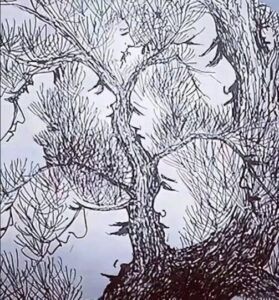Pareidolia: Why Our Brains See Faces in Trees – The Hidden Art of Human Perception
Have you ever found yourself staring at the bark of a tree and suddenly noticing what looks like a human face staring back at you? Maybe it appeared to smile, frown, or display an expression you couldn’t quite explain. This captivating experience is not your imagination playing tricks—it is a psychological phenomenon known as pareidolia. Pareidolia is our brain’s natural tendency to recognize familiar patterns, especially faces, in random shapes, textures, or natural objects. This instinct is deeply rooted in human evolution and continues to influence how we interpret the world around us today.
The Science Behind Pareidolia
Our brains are wired to detect faces almost instantly. Early humans relied on this ability to quickly identify friends, foes, and potential threats in their environment. Even though our surroundings have changed dramatically with modern life, that ancient survival mechanism is still active. When we glance at clouds, mountains, trees, or even the front of a car, our minds try to assign meaning. Seeing a “face” provides a sense of familiarity and comfort.
Pareidolia in Nature: The Tree Illusion
One of the most captivating examples of pareidolia can be seen in tree bark illusions. These artistic renderings or naturally formed textures often seem to hide human profiles within their branches, trunks, and roots. At first glance, the image may appear to be just a normal tree. But when you observe more closely, subtle human features—like eyes, noses, lips, and even hair—start to emerge from the shapes formed by shadows and negative spaces.
Some tree illusion artworks are intentionally designed to include multiple faces. You might see:
-
Lovers embracing in the curves of the trunk
-
Wise elders with solemn expressions hidden in the branches
-
Children laughing within the roots and lower foliage
Each face reveals itself gradually, creating a sense of wonder and engagement that keeps viewers looking longer—the exact quality that makes this type of content perfect for platforms like Google AdSense, where higher viewer engagement translates to better ad revenue performance.
Why Artists Use Pareidolia
Artists often incorporate pareidolia into their work to spark curiosity. When hidden faces are cleverly embedded into natural forms like trees, rocks, or rivers, viewers are invited to not just see the artwork—but to interact with it. This interactive element increases viewing time, emotional connection, and shareability, all of which are essential factors for boosting website traffic.
The Emotional Impact of Hidden Face Art
Hidden face illusions tap directly into our emotional and psychological responses:
-
They stimulate curiosity – Viewers feel compelled to search for every hidden face.
-
They spark imagination – The mind begins to wonder who these faces represent and what stories they tell.
-
They offer relaxation – Focusing on subtle patterns can be meditative and soothing, much like nature therapy.
Pareidolia as a Reflection of the Human Mind
What makes pareidolia fascinating is that it tells us as much about ourselves as it does about the object we are observing. The faces we see often reflect our own emotions, memories, or subconscious thoughts. A peaceful face in a tree might reflect our own desire for calm, while a mysterious profile could symbolize curiosity or introspection.
Discover the Hidden World Around You
Next time you walk in nature, take a moment to look closely at a tree. Don’t just observe its shape—engage with it. You may begin to notice human-like figures emerging from the bark, animals appearing in the branches, or expressions forming in the twisting roots. What seems like an ordinary tree can transform into a living gallery of hidden characters.
This simple act of observation reminds us of how incredible the human brain truly is. It has the ability to find beauty, meaning, and connection in places where others may see nothing at all.
